|
XI.
|

|
The odalisque in Louis Courtat's picture is dreaming away a drowsy day, lulled by
the monotonous melody of the Turkish mandolin with whose strings her slave girl toys with
listless fingers. The artist was born in Paris in 1847. He was a pupil of Cabanel, and
with his first exhibit at the Salon, in 1873, won his first medal. In each of the two
succeeding years he took other medals which placed him in the positon known at the French
exhibitions as being hors concours, or out of competition for any medals except that known
as the medal of honor. In 1878 another honor fell to Courtat in the purchase by the State of his
picture "Spring" which is now in the collection of the Luxembourg.
"The Odalisque" was his Salon picture for 1882.
|
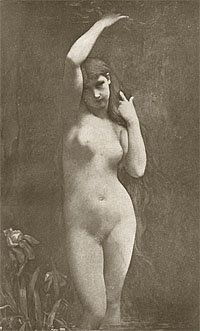
|
"Undine" was the Salon picture of Jules Lefebvre for
1882. Since the Baron de la Motte Fouque wrote his exquisite tale, "Undine," the type was
assumed a personal rather than a general character, and the "Undine" of the painters is no longer any
spirit of the waves but the one spirit of the famous romance.
|

|
C.A. Lenoir, the painter of "The Novel," is
a Parisan, young and of rising reputation since he began to exhibit three or four years ago.
|

|
Leon Perrault represents Venus enthroned in her chariot, in which she traverses her natal waves.
|
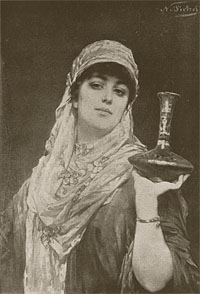
|
N. Sichel's "Bayadere" is an Oriental dancing-girl wo carries the bottle of water the balancing of which on her head is one of the features of her senuous and alluring performance.
|
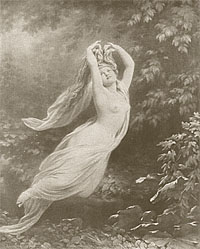
|
Fritz Zuber-Buhler
in "The Dew" represents her as a lovely spirit almost spectral in her pale beauty, who flies over
the landscape which is shimmering in the moonbeams, shaking out from the tresses of her golden
hair the pearls of moisture which fall upon and refresh the earth. It is a charming conceit, and rendered
with a sentiment and feeling which rank it among the very best works the artist has produced.
|

|
The sensation of the Paris salon for 1878 was, paradoxical as it may seem, a painting which was not there.
It was a canvas by Henry Gervex, and was founded on the last lines of
Alfred de Musset's famous poem, "Rolla."
It was a masterpiece, one of the few real great works of modern art. Artists and critics alike
loaded it with applause, and hailed the painter with acclamations as he took his afternoon promenade. But
the Administration of the salon, happened to be in a particularly censorious mood that spring, and excluded
the picture. The artist then exhibited it in the gallery of a dealer in the Rue de la Chaussee-d'Antin, where all
Paris flocked to see it. It was probably the most successful private exhibition ever
made in Paris, and it laid a secure foundation for the artist's fortune.
Henri Gervex was born in Paris in 1852. He commenced to study art under the venerable master Pierre Nicholas Brisset,
then studied under Fromentin, and finally concluded his course under Cabanel. In 1873 he exhibited for the first time
"A Bather Sleeping," a remarkable study of the nude. The next year he took a medal of the second class, with the
"Satyr Sporting with a Bacchante," a picture which was purchased by the State for the Luxembourg. In 1876 he
was medalled again, for a powerful realistic picture, representing the surgeons holding an autopsy
on the body of a patient in the Hotel Dieu hospital. In 1877 the state purchased another of his pictures,
a communion scene in a village church which is now in the Government collection. All this while his fame
had been rising steadily, but th struggle was still severe when the sensation caused by "Rolla" brought
it to a climax, and added a new master to the roll of honor of French art. Commissions for portraits
rolled in, his pictures were sold from the easel, he received so many orders for the decoration of
private houses that he was compelled to refuse a portion
of them, and two years after the State had rejected his "Rolla" it annointed the wound with balm by
appointing him to paint the great decorative panels for the Mayor's Office of the Nineteenth Arrondissement.
This engagement secured him also
admission into the legion of Honor. When "The Masked Model" appeared at the
Salon, it created a sensation second only to that of the picture which did not
appear. It became popularly rumored that the original was a great lady, who had
consented to pose for the artist under condition that her face should be covered so as to prevent her
from being identified, and this added piquant interest to the magnificent art displayed in the picture.
As a matter of fact, however, it was only the figure of a professional model. While posing for
Gervex she had, in a spirit of fun, put on a ball mask which was hanging to the wall, and the
effect was so original that the artist used it for his finished picture.
|
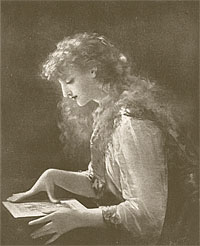
|
"The Young Connoisseur," by Paul Prosper Tillier, is a fair-haired girl who examines an etching or
engraving. The artist is a native of Baupere in the Vendee and a pupil of Leon Cogniet.
|

|
William Kray illustrates another page of the Rhine legends
by his "Lorelei and Igorne."
|

|
In "Attention" Miss Coomans shows a Greek girl, who has been preparing
an offer of incense and flowers to her household deity, on the terrace, and who interrupts it to
watch curiously something which is occurring or some one who is passing in the street below.
|
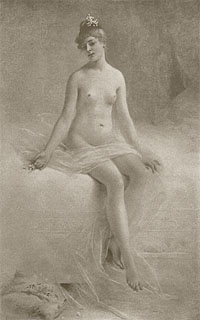
|
"Fragility" is one of a series of decorative panels painted by
J.F. Ballavoine for the boudoir of a
Paris mansion. The subject is a fair social enchantress who, after a great ball, has disrobed and
casts herself wearly on her ouch, and in doing so has broken the pearl ornaments she wears in her hair.
A natural idea might suggest itself to a possibly cynical observer that the jewel was not the only
fragile object in the picture.
|

|
C. Schweninger, Jr., is the son of the eminent German landscape painter, Carl Schweninger. The elder
Schweninger was born at Vienna in 1818, and was one of the most esteemed painters in his line of his time.
His son was his pupil, but also
studied the figure at the Vienna and Munich Academies, and combines them, as in "A Quiet Nook," in fine idyllic feeling.
|
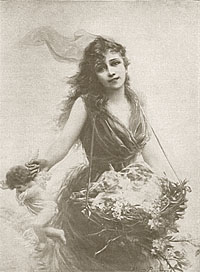
|
"Spring's First Flowers" is another of the
decorative fancies of Edouard Bisson. The flowers are Cupidons, who have been
warmed to life by the gentle atmosphere of the season.
|

|
The dream of Joseph Coomans' Pompeiian maiden is evidently one of those which come by day to young
ladies not insensible to the sentiment of love.
|

|
Edouward Dantan, who was born in Paris in 1848, seemed to come into art as
into a heritage. His grandfather, who had been a soldier under the First Empire, was distinguished as a sculptor
in wood. His father, the eldest son of the veteran, born at St. Cloud, where he died in 1878, in 1798 became
a sculptor in marble and left many remarkable decorative works and statues. His uncle, the younger son,
also became a sculptor, and was famous especially for his caricature portraits in clay and bronze,
and for his burlesque and satirical portraits in crayon of current celebrities and notorieties. Edouard
Danton entered the Ecole des Beaux Arts as a student, and under the mastership of Pils and Lehmann made such
rapid progress that in 1867 the Government commissioned him for some important decorative compositions.
Two years later he showed his first picture at the Salon, a picture which had somewhat curious adventures. In 1870
the artist had gone to paris to volunteer in the army against the Prussians. He left his studio at St. Cloud
locked up. When he returned to the town he found that the studio had been burned down during the Prussian
occupation and supposed the picture had been destroyed. Some
years after, however, it was by accident found at Versailles, rolled up around a broomstick. It had bene cut
from the stretcher when the invaders sacked the studio, and carried off by some soldier who probably
intended to keep it, but who afterward, when the Germans evacuated Versailles, forgot it and left it behind.
In 1874 Dantan received his first Salon medal, for a picture of a monk making a wood-carving, which the
State purchased for the nantes Museum. In 1875 he won a gold medal at the Rouen Exposition with a picture
which was purchased by the city for its municipal museum. In 1880 he took another Salon medal for a picture
of his father sculpturing a bas-relief, which the State bought for the Luxembourg. This seemed to give a
new direction to his talent, and he painted a number of pictures representing these artistic interiors,
all of which enjoyed great
success. "Modelling from Life" represents the workshop of a maker of plaster casts. In the background
are seen casts from the antique; one of a figure by Michel Angelo, and one of a head by Donatello; the
mortar with its swinging pestle for pulverizing plaster, sacks of plaster, and the tubs, bowls, sieves,
and the like used in the trade. The mould maker has been taking a cast from life. The nude model is
perched on the stand, and the master is removing the first half of the mould from her leg, while his
assistant holds the section section in place. These casts from life of arms and legs are very generally
used in the preliminary drawing classes of the art schools. Dantan, as this picture shows, was a realist,
but in the purest spirit. he enjoys high and profitable repute as a portrait painter also.
|

|
A part of F.A. Clement's labor during his long sojourn in Egypt was in painting pictures for the uncle of the
Khedive. He was only partially paid for these, and after his return to France instituted a long and costly
suit against the old Egyptian voluptuary for the balance. Unfortunately for him the Khedive was deposed and
pensioned off in exile, so the poor artist had only his trouble for his pains, for the ruin of Halim Pacha, the
uncle, followed his nephew's deposition. One of the last pictures Halim Pacha ordered from him was a portrait
of a new Circassian slave whom he had bought, but the artist refused to deliver it and took it to France
with him, where he finished and sent it tot he Salon of 1880. It proved extremely successful, and won the
artist much merited credit. "A Circassian Woman in the Harem" is now in one of the French provincial museums.
|
|
|
|





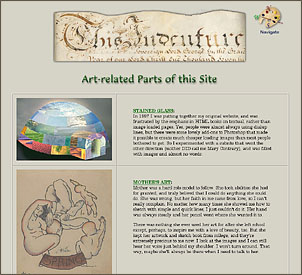



![]() Copyright © 2007, Mary S. Van Deusen
Copyright © 2007, Mary S. Van Deusen